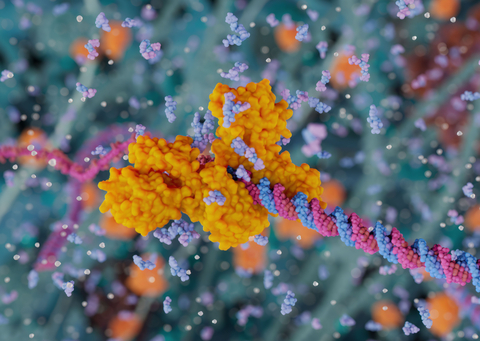ROME Therapeutics announced a landmark publication in Nature revealing the first high-resolution structure of the LINE-1 reverse transcriptase.
- Research completed through collaboration with leading institutions produced the structure of LINE-1 RT using X-ray crystallography and cryo-electron microscopy, which can enable further rational drug design
- Publication outlines key LINE-1 RT mechanisms that activate the innate immune system, leading to disease-driving inflammatory response
- Findings further support ROME’s development of novel LINE-1 RT inhibitors for autoimmune disorders
BOSTON--(BUSINESS WIRE)-- ROME Therapeutics, a biotechnology company harnessing the power of the dark genome to develop breakthrough medicines for serious diseases, today announced a landmark publication in Nature revealing the first high-resolution structure of the LINE-1 reverse transcriptase (RT). The publication, “Structural analysis and inhibition of human LINE-1 ORF2 protein reveals novel adaptations and functions,” by Baldwin et al., also validates that LINE-1 RT activity in the cytoplasm is a key driver of the innate immune response and supports ROME’s approach to developing novel LINE-1 RT inhibitors for autoimmune disorders. The supporting research was co-led by ROME as part of a significant collaboration with more than a dozen leading academic groups and industry organizations.
This press release features multimedia. View the full release here: https://www.businesswire.com/news/home/20231214251491/en/

LINE-1 reverse transcriptase (orange) can produce RNA-DNA hybrids in the cytoplasm, a new study finds. These aberrant products can trigger inflammation, and might explain how LINE-1 contributes to autoimmune disease and other disease biology. Credit: MoA animation by Visual Science, 2023, and published by Baldwin et al. in Nature (doi 10.1038/s41586-023-06947-z)
“ROME is proud to be part of this historic research effort to solve the structure of LINE-1’s RT, insights which have already informed the structure-based drug design work which served as the foundation of our lead program,” said Rosana Kapeller, M.D., Ph.D., President, CEO and Co-founder of ROME. “The publication’s biochemical analyses also provide the first confirmatory evidence of the mechanisms by which LINE-1 RT leads to a disease-driving inflammatory response, which is the basis for ROME’s development of novel LINE-1 RT inhibitors to treat autoimmune disease. We believe that sharing these data with the scientific community will galvanize research into the dark genome’s role in disease and human health.”
Dr. Kapeller continued, “We would like to dedicate this publication to our colleague, Eric Baldwin, who was a visionary research scientist in structure-based drug discovery and was instrumental in solving the crystal structure of LINE-1 RT. This research is a testament to Eric’s work and to his lasting scientific legacy, which continues to drive the field forward.”
LINE-1 is a virus-like element that makes up about one-fifth of the human genome and encodes two proteins, one of which is ORF2 protein (ORF2p). ORF2p is responsible for LINE-1’s RT and endonuclease activities, which have been implicated in the pathophysiology of cancers, autoimmune diseases and neurodegeneration.
In the Nature publication, ROME and collaborators report, for the first time, X-ray crystallography and cryo-electron microscopy (cryo-EM) studies of the RT domain of ORF2p in multiple conformational states, revealing two novel folded domains that contribute to unique aspects of the LINE-1 lifecycle and insertion mechanisms. Importantly, the study also provides the first conclusive evidence that LINE-1 RT can activate the innate immune system by synthesizing RNA-DNA hybrids in the cytoplasm, triggering signaling via the cGAS/STING pathway, resulting in interferon production. This viral mimicry may explain how LINE-1 contributes to autoimmune and other inflammatory diseases.
“We’ve been dreaming about solving the 3D structure of LINE-1 ORF2 protein for more than 20 years,” said Jef Boeke, Ph.D., Sol and Judith Bergstein Director, Institute of System Genetics and Professor, Department of Biochemistry and Molecular Pharmacology at NYU’s Grossman School of Medicine and a member of ROME’s Scientific Advisory Board. “I am certain that these new structural insights into LINE-1 RT will open countless lines of new scientific inquiry, as we seek to leverage the understanding of how LINE-1 contributes to disease and how to interrupt its pathological activity with new treatment approaches.”
About LINE-1
Long Interspersed Nuclear Elements, or LINEs, are a ubiquitous family of transposable, virus-like elements embedded in the dark genome at the DNA level. A LINE can make new copies of itself through a reverse transcriptase mechanism. LINE-1 encodes several proteins, including a protein called ORF2, which contains both a reverse transcriptase (RT) domain that can reverse transcribe the LINE-1 RNA, making a new DNA copy, and an endonuclease domain, that can insert the DNA copy into a new genomic location. Activity of LINE-1 RT in the cytoplasm can result in cytosolic RNA-DNA hybrids triggering an innate immune response that can drive autoimmune disease pathology. Through rational structure-based drug design, ROME has designed novel, selective and potent inhibitors of LINE-1 RT to block this immune response, which are now in preclinical development for lupus and other autoimmune diseases.
About ROME
ROME Therapeutics is developing novel therapies for a range of serious diseases, including autoimmune disease, cancer and neurodegeneration, by illuminating the role of the dark genome — the vast genomic expanse beyond the traditional genes, which includes virus-like repetitive elements and non-coding sequences — in human health and disease. Leveraging the company’s unprecedented data sciences platform, ROME has built a deep pipeline of therapies targeting the dark genome. To lead this exploration, ROME has assembled a team of world-class leaders in drug discovery and development across immunology, oncology, chemistry and machine learning. ROME is based in Boston, Mass. For more information, please visit www.rometx.com.
View source version on businesswire.com: https://www.businesswire.com/news/home/20231214251491/en/
Contacts
Investors
Monique Allaire
THRUST Strategic Communications
monique@thrustsc.com
Media
Lisa Raffensperger
Ten Bridge Communications
lisa@tenbridgecommunications.com
Source: ROME Therapeutics
LINE-1 reverse transcriptase (orange) can produce RNA-DNA hybrids in the cytoplasm, a new study finds. These aberrant products can trigger inflammation, and might explain how LINE-1 contributes to autoimmune disease and other disease biology. Credit: MoA animation by Visual Science, 2023, and published by Baldwin et al. in Nature (doi 10.1038/s41586-023-06947-z)
View this news release and multimedia online at:
http://www.businesswire.com/news/home/20231214251491/en







